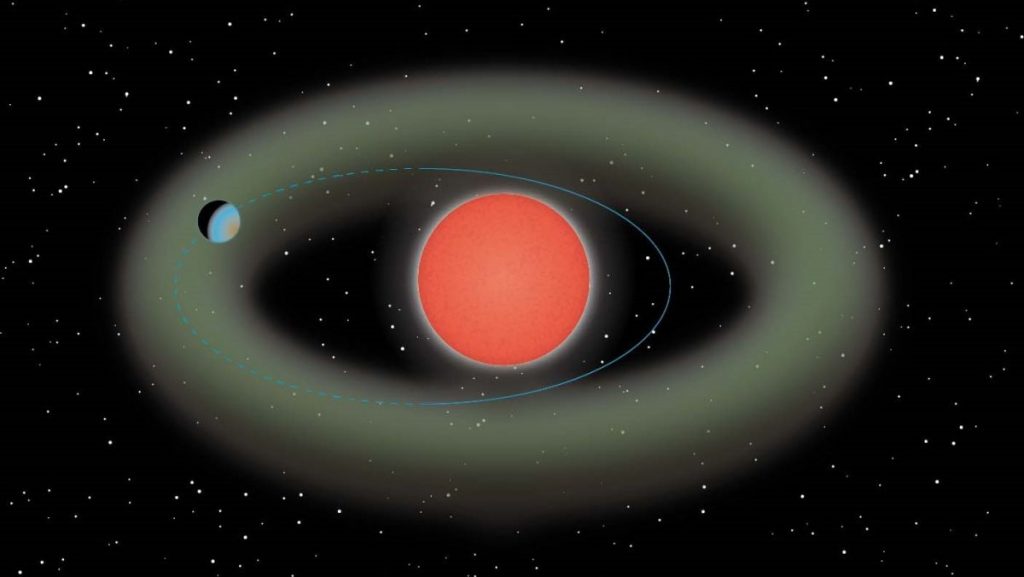
Super-Earth planet zips through the habitable zone of red dwarf star (Image Credit: Space.com)
Astronomers have discovered a ‘super-Earth’ orbiting a red dwarf star just 37 light-years from our solar system.
The exoplanet Ross 508 b skims the so-called habitable zone of its parent star, the area in which surface temperatures are suitable to allow for the existence of liquid water, a key ingredient of life. The newly discovered exoplanet has about four times the mass of Earth and was discovered using a new infrared monitoring technique. The proximity of this super-Earth to our planet means it is ripe for atmospheric investigation, which could help researchers determine whether life could exist around low-mass stars.
“To have the very first planet discovered by this new method be so tantalizingly close to the habitable zone seems too good to be true and bodes well for future discoveries,” team leader and Tokyo Institute of Technology professor Bun’ei Sato said in a statement.
Related: These 10 super extreme exoplanets are out of this world
Red dwarfs like Ross 508, which has about one-fifth of the mass of the sun, are small stars that account for around three-quarters of all stars in our galaxy, the Milky Way. These stars are especially abundant in the region around our solar system, making red dwarf stars and their systems ideal targets for the search for planets outside the solar system and the investigation of possible life elsewhere in the universe.
The fact that red dwarfs are small means that they are cool, with temperatures of between 2,000 and 3,500 Kelvin. Their relatively low temperatures make them dim in visible light, unlike larger stars, and means astronomers must study them in infrared.
In order to do this, the Astrobiology Center in Japan developed an infrared observational instrument called the InfraRed Doppler instrument (IRD) to mount on the Subaru Telescope in Hawai’i. With this instrument — the world’s first high-precision infrared spectrograph for an 8-meter class telescope — the astronomers set about searching for signs of planets around red dwarf stars.
Specifically, the researchers looked for the tell-tale ‘wobble’ that an exoplanet causes in the orbit of its parent star; the wobble registers as a tiny shift in the wavelength of light from the star as it moves toward and away from Earth.

The discovery of Ross 508 b marks the first success for the project, which is officially named the IRD Subaru Strategic Program (IRD-SSP).
“It has been 14 years since the start of IRD’s development,” Sato said. “We have continued our development and research with the hope of finding a planet exactly like Ross 508 b.”
Ross 508 b, just the third planet to be found around such a low-mass star, has an average distance from its parent star of just one-twentieth times the distance between Earth and the sun. The astronomers who discovered it believe that the planet’s highly elliptical orbit carries it into Ross 508’s habitable zone every 11 days.
“Ross 508 b is the first successful detection of a super-Earth using only near-infrared spectroscopy,” Subaru Telescope researcher Hiroki Harakawa said in the statement. “Prior to this, in the detection of low-mass planets such as super-Earths, near-infrared observations alone were not accurate enough, and verification by high-precision line-of-sight velocity measurements in visible light was necessary.” (Although super-Earths are larger than our own planet, most of the exoplanets scientists are currently detecting are much larger.)
Harakawa added that the study, for which he was the lead author, shows that even acting alone IRD-SSP is capable of detecting planets. He said the work especially demonstrates the advantage of IRD-SSP in its ability to detect planets with high precision even around late-type red dwarfs that are too faint to be observed with visible light.
The team’s research was published June 30 in the journal Publication of the Astronomical Society of Japan (PASJ).
Follow us on Twitter @Spacedotcom and on Facebook.





